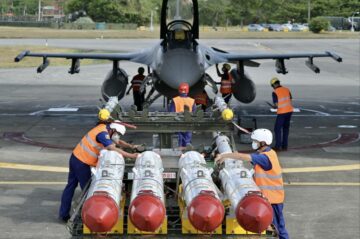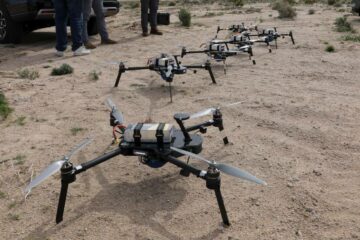
Military leaders and outside analysts have warned for years that China is making rapid progress in space.
Gen. Stephen Whiting, commander of U.S. Space Command, recently cautioned that China is “growing its military space and counterspace capabilities at breathtaking pace.” He cited China’s rapid increase in space-based surveillance capabilities in particular, saying it had tripled in number since 2018 to 359 surveillance satellites. Maj. Gen. Greg Gagnon, deputy chief of space operations for intelligence, said that since 2015, China has increased its number of satellites by 550%.
These numbers are understandably alarming, but they don’t tell the whole story.
The figures military leaders cite include more than China’s military and intelligence satellites. As shown in the AEI Space Data Navigator, China has 848 operational satellites as of May 2024, compared to just 129 in 2015 (an increase of just over 550%) — but the vast majority of these are not military satellites.
Of the 848 Chinese satellites operating today, 179 are military and intelligence satellites, 271 are civil (including the Beidou constellation for navigation and timing), 362 are commercial and 36 are academic. To put this in perspective, the United States has a total of 6,975 operational satellites today — eight times as many as China — and since 2015, the total number of U.S. satellites has increased by over 2,100%.
Why are military leaders so concerned? It’s because the lines between Chinese military, civil and commercial satellites are blurred, and in a conflict the United States expects that all Chinese space assets can and will be used by the military. The same is not true for the United States, and the vast majority (94%) of U.S. satellites are commercial.
When the total number of Chinese satellites is compared to only U.S. military and intelligence satellites, the picture is different. The United States has just 300 military and intelligence satellites in operation — roughly a third of China’s total space assets.
While China’s rapid advances in space and counterspace technology is concerning, the United States’ failure to fully leverage the innovation of its own commercial space sector is even more concerning. The creation of the Commercial Augmentation Space Reserve (CASR) is a step in the right direction, but it is only a small step because it merely creates the option to use commercial satellites in a crisis. To put this in perspective, the Civil Reserve Air Fleet that served as an inspiration for CASR has only been used three times in the 73 years since it was created.
As I detailed in a recent report, the vibrance and innovation of the U.S. commercial space sector is the envy of the world, and it is rooted in our free market economic system, open society and access to capital — an enduring advantage we have over China. In 2023, the U.S. commercial space sector alone (not including government missions) launched three times as many satellites as the rest of the world combined, and U.S. effective launch capacity in 2023 was four times the rest of the world combined.
China is not ahead of the United States in space by any stretch of the imagination. It’s the U.S. military and intelligence community that are falling behind the commercial space sector and losing ground to China. But it doesn’t have to be this way.
Congress and the Biden administration need to unleash the full potential of the Space Force to compete with China, and the best way to do that is to build on what is already working. The Space Development Agency (SDA) has found the right approach to leverage commercial innovation in its proliferated warfighter space architecture. It is using a spiral development approach, with each “tranche” of satellites having progressively better capabilities, and it is leveraging commercial technology and components wherever possible. Right now, it is working on two “layers” of the architecture: the data transport layer and the missile tracking layer.
But the SDA could do more if given the resources. In particular, it should immediately begin work on a tactical intelligence, surveillance and reconnaissance (ISR) layer — what it has previously referred to as the “custody” layer.
The National Reconnaissance Office (NRO) and the Space Force are debating a constellation of satellites for ground moving target indication (GMTI) — a mission that was traditionally the responsibility of the Air Force. Gen. Jay Raymond, the former chief of space operations, announced that the GMTI mission would be moving to the Space Force three years ago, and yet the program has still not reached milestone B — the formal start of an acquisition program.
China is not waiting for the NRO and Space Force to settle their bureaucratic disputes over how the satellites will be controlled. The Biden administration should stop the internal bickering and give the tactical ISR mission (including GMTI and other types of space surveillance) to the Space Development Agency. And if the administration doesn’t settle the issue soon, the Armed Services committees should settle it for them in the fiscal 2025 National Defense Authorization Act (NDAA).
Building a new tactical ISR layer as part of the Space Development Agency’s overall proliferated architecture is the fastest and most assured way to make meaningful progress. But even this will take several years to begin delivering capabilities to the warfighter. In the interim, the Space Force should begin integrating existing commercial space ISR capabilities to fill the capability gap.
Contracting for commercial space ISR has traditionally been the job of the NRO, and the agency already has large contracts for commercial electro-optical imagery. But the NRO has not moved ahead expeditiously in expanding its use of commercial synthetic aperture radar and radio frequency-sensing satellites, and the NRO’s business model for tasking and processing commercial space ISR data is far too slow to support tactical users (taking days rather than minutes).
Congress should create a commercial space ISR fund in the fiscal 2025 budget and require the Space Force to begin contracting for commercial space ISR capabilities. This would jumpstart the process of integrating commercial capabilities into DOD battle networks and kill chains and give the Space Force an opportunity to refine the requirements for its own tactical ISR satellites.
A limiting factor in all of this is (unsurprisingly) funding, and the budget caps imposed by the Fiscal Responsibility Act are one reason the Space Force was not more forward-leaning in its budget request. While in an ideal world Congress would add new funding for these priorities, if that is not possible, it could instead take money from lower priorities within the Space Force’s budget.
An example of a potential bill payer is the funding line for narrowband satellite communications, intended to extend the life of the current Mobile User Object System (MUOS) constellation of satellites the Space Force inherited from the Navy. A previous estimate showed that it will cost $4.8 billion to buy two more of these satellites — the very definition of big, juicy targets.
Narrowband satellite communications is a mission area that can transition to commercial, where private-sector capacity and performance (e.g., latency, data rates, etc.) are far better than MUOS. Canceling the MUOS life extension would save $280 million in fiscal 2025 alone, and Congress could rescind any unobligated money it appropriated in fiscal 2024 to free up even more funding within the Space Force’s budget. This would be more than enough for SDA to start work on a tactical ISR layer and to create a commercial space ISR fund.
Congress and the executive branch should heed the warnings about China’s space capabilities. The United States enjoys a substantial lead in space technology, but China is moving quickly to copy our technology and counter the advantage it provides. It is time to get serious and to make the hard choices. It is time to unleash the Space Force.
Todd Harrison is a senior fellow at the American Enterprise Institute, focused on defense strategy and budgeting, the defense industrial base, and space policy and security.
- SEO Powered Content & PR Distribution. Get Amplified Today.
- PlatoData.Network Vertical Generative Ai. Empower Yourself. Access Here.
- PlatoAiStream. Web3 Intelligence. Knowledge Amplified. Access Here.
- PlatoESG. Carbon, CleanTech, Energy, Environment, Solar, Waste Management. Access Here.
- PlatoHealth. Biotech and Clinical Trials Intelligence. Access Here.
- Source: https://www.defensenews.com/opinion/2024/05/21/unleash-the-space-force/
- :has
- :is
- :not
- :where
- $UP
- 179
- 2%
- 2015
- 2018
- 2023
- 2024
- 2025
- 300
- 36
- 362
- 6
- 70
- 73
- 8
- a
- About
- academic
- access
- acquisition
- Act
- add
- administration
- advances
- ADvantage
- agency
- ago
- ahead
- AIR
- Air Force
- All
- alone
- already
- American
- an
- Analysts
- and
- announced
- any
- approach
- architecture
- ARE
- AREA
- armed
- AS
- Assets
- assured
- At
- authorization
- b
- base
- Battle
- BE
- because
- been
- begin
- behind
- BEST
- Better
- between
- biden
- Biden Administration
- Bill
- Branch
- breathtaking
- budget
- budgeting
- build
- business
- business model
- but
- buy
- by
- CAN
- capabilities
- capability
- Capacity
- capital
- caps
- chains
- chief
- China
- Chinas
- chinese
- choices
- cited
- civil
- combined
- command
- commercial
- committees
- Communications
- community
- compared
- compete
- components
- concerned
- concerning
- conflict
- Congress
- contracting
- contracts
- controlled
- copy
- Cost
- could
- Counter
- create
- created
- creates
- crisis
- Current
- data
- Days
- debating
- Defense
- definition
- delivering
- deputy
- detailed
- Development
- different
- direction
- do
- DoD
- Doesn’t
- Dont
- e
- each
- Economic
- economic system
- Effective
- eight
- enduring
- enjoys
- enough
- Enterprise
- estimate
- etc
- Even
- example
- executive
- existing
- expanding
- expects
- extend
- extension
- factor
- Failure
- Falling
- far
- fastest
- fellow
- Figures
- fill
- Fiscal
- FLEET
- focused
- For
- Force
- formal
- Former
- found
- four
- Free
- from
- full
- fully
- fund
- funding
- gap
- Gen
- get
- Give
- given
- Government
- greg
- Ground
- had
- Hard
- Have
- having
- he
- How
- hq
- HTTPS
- i
- ideal
- if
- images
- imagination
- immediately
- imposed
- in
- include
- Including
- Increase
- increased
- indication
- industrial
- Innovation
- Inspiration
- instead
- Institute
- Integrating
- Intelligence
- intended
- interim
- internal
- into
- issue
- IT
- ITS
- Job
- jpg
- just
- Kill
- large
- Latency
- launch
- launched
- layer
- lead
- leaders
- Leverage
- leveraging
- Life
- life extension
- limiting
- Line
- lines
- losing
- lower
- Majority
- make
- Making
- many
- Market
- May 2024
- May..
- meaningful
- merely
- milestone
- Military
- minutes
- Mission
- missions
- Mobile
- model
- money
- more
- most
- moved
- moving
- National
- Navigation
- Need
- networks
- New
- New Funding
- now
- number
- numbers
- object
- of
- Office
- on
- ONE
- only
- open
- operating
- operation
- operational
- Operations
- Opportunity
- Option
- Other
- our
- outside
- over
- overall
- own
- Pace
- part
- particular
- performance
- perspective
- picture
- plato
- Plato Data Intelligence
- PlatoData
- policy
- possible
- potential
- previous
- previously
- priorities
- process
- processing
- Program
- Progress
- progressively
- provides
- put
- quickly
- rapid
- Rates
- rather
- reached
- reason
- referred
- refine
- request
- require
- Requirements
- Reserve
- Resources
- responsibility
- REST
- right
- rooted
- roughly
- s
- Said
- same
- satellite
- satellites
- Save
- saying
- sector
- security
- Senate
- senior
- serious
- served
- Services
- settle
- several
- should
- showed
- shown
- since
- slow
- small
- So
- Society
- Soon
- Space
- Space Force
- space-based
- spiral
- start
- States
- Step
- Stephen
- Still
- Stop
- Story
- Strategy
- stretch
- substantial
- support
- surveillance
- system
- tactical
- Take
- taking
- Target
- targets
- Technology
- tell
- than
- that
- The
- the world
- their
- Them
- These
- they
- Third
- this
- three
- time
- times
- timing
- to
- today
- too
- Total
- Tracking
- traditionally
- transition
- transport
- true
- two
- types
- u.s.
- Understandably
- United
- United States
- unleash
- use
- used
- User
- users
- using
- Vast
- very
- Waiting
- warned
- was
- Way..
- we
- What
- What is
- wherever
- while
- whole
- will
- with
- within
- Work
- working
- world
- would
- years
- yet
- zephyrnet












